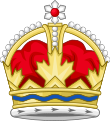This is an old revision of this page, as edited by 76.66.195.159 (talk) at 12:02, 9 December 2008 (→Notes). The present address (URL) is a permanent link to this revision, which may differ significantly from the current revision.
Revision as of 12:02, 9 December 2008 by 76.66.195.159 (talk) (→Notes)(diff) ← Previous revision | Latest revision (diff) | Newer revision → (diff)| This article does not cite any sources. Please help improve this article by adding citations to reliable sources. Unsourced material may be challenged and removed. Find sources: "Official Opposition" Canada – news · newspapers · books · scholar · JSTOR (January 2008) (Learn how and when to remove this message) |
| Politics of Canada |
|---|
 |
| Government (structure) |
| The Crown |
| Executive |
| Legislative |
| Judicial |
| Elections |
| Local government |
|
Foreign relations
|
| Crown and Indigenous peoples |
| Related topics |
In Canada Her Majesty's Loyal Opposition (Template:Lang-fr), commonly known as the Official Opposition, is usually the largest parliamentary opposition party in the House of Commons or a provincial legislative assembly that is not in government either on its own or as part of a governing coalition. This is usually the second-largest party in a legislative house, although in certain unusual circumstances, it may be a third or fourth party or even the largest party.
The Official Opposition is viewed as the caucus tasked with keeping the government in check. It is also generally viewed as the alternative government. The Official Opposition maintains a shadow cabinet of Members of Parliament (MPs) that often have the same portfolios as actual ministers. They are known as opposition "critics", or "spokespersons".
It is styled as "Her Majesty's Loyal Opposition" to show that, although the group may be against the sitting government, it remains loyal to the Crown (the embodiment of the Canadian state), and thus to Canada.
The leader of the Opposition party is called the "Leader of the Opposition." The federal Leader of the Opposition may live in Stornoway, which is the official residence provided for him or her in Ottawa.
There are some benefits to being the Official Opposition. The Official Opposition is the party that gets to speak first after the government, and gets more time in question period than any other party. It also gets more funding for research and staff than other parties.
History
After the 1921 election, the Progressive Party, a looseknit largely-agrarian "protest" party, won the second largest amount of seats to William Lyon Makenzie King's Liberals, but declined to be the Official Opposition because of their lack of national organization. The third-place Conservative Party, led by Arthur Meighen, thus became the Official Opposition.
As a result of the 1925 election, the Official Opposition was actually the largest party in the House of Commons, the Conservatives. The Liberals, led by Mackenzie King, were able to form a minority government despite the fact that they had a dozen fewer seats than the Conservatives because King's Liberals were able to win the support of the Progressives to remain in government. Similarly, in Ontario, the Ontario Liberal Party was able to form a minority government from 1985 to 1987 despite having fewer seats than the Ontario Progressive Conservative Party because of the support of the Ontario New Democratic Party.
In 1993, the Reform Party challenged whether the Quebec sovereigntist Bloc Québécois could hold the position of official opposition. The Speaker ruled in favour of the Bloc, however.
The current Official Opposition is the Liberal Party of Canada, since the Conservative Party of Canada was sworn in as government on February 6, 2006.
Senate
There is also an Official Opposition in the Canadian Senate. This is the largest party in the Senate that is not in government. As the governing party is determined in the House of Commons, the Official Opposition in the Senate may actually be larger than the government party in the Senate. It is customary, however, for the Senate to pass legislation approved in the House of Commons even if the government has a minority in the Senate. Although the Senate nominally has the power to block most legislation (excepting bills which would trigger a non-confidence motion if defeated in the House, such as money bills), this power is rarely exercised in practice.
The party that forms Official Opposition in the Senate is not necessarily the same party as in the House of Commons, however. From 1993 to 2003, the Official Opposition in the Senate was the Progressive Conservative Party of Canada, even though the Bloc Québécois from the Official Opposition in the House from 1993 to 1997, followed by the Reform Party of Canada, and then the Canadian Alliance from 1997 to 2003. This is because the BQ, and Reform Party had no Senators. However, when Senator Gerry St. Germain crossed the floor from the Progressive Conservatives to the Canadian Alliance in 2000, he argued that he should be recognized as Leader of the Opposition in the Senate as the Canadian Alliance formed the Official Opposition in the House of Commons. The Speaker of the Canadian Senate ruled against him, however, as the Progressive Conservatives were the larger opposition party.
Lists of Official Oppositions
Notes
The Liberal-Conservative Party became the Conservative Party in 1873, however some memebrs still sat and were elected as Liberal-Conservatives after the change.
From 1921 to 1924, the Progressive Party of Canada had more MPs than the Conservative Party, but it turned down the chance of being Official Opposition, and the position passed to the Tories.
The Conservative Party became the Progressive Conservative Party in 1945.
House of Commons only. The Progressive Conservative Party formed the Official Opposition in the Senate during this period.
The Reform Party became the Canadian Alliance in 2000.
The Canadian Alliance and the Progressive Conservative Party merged to form the Conservative Party in 2004.
Further information: ]